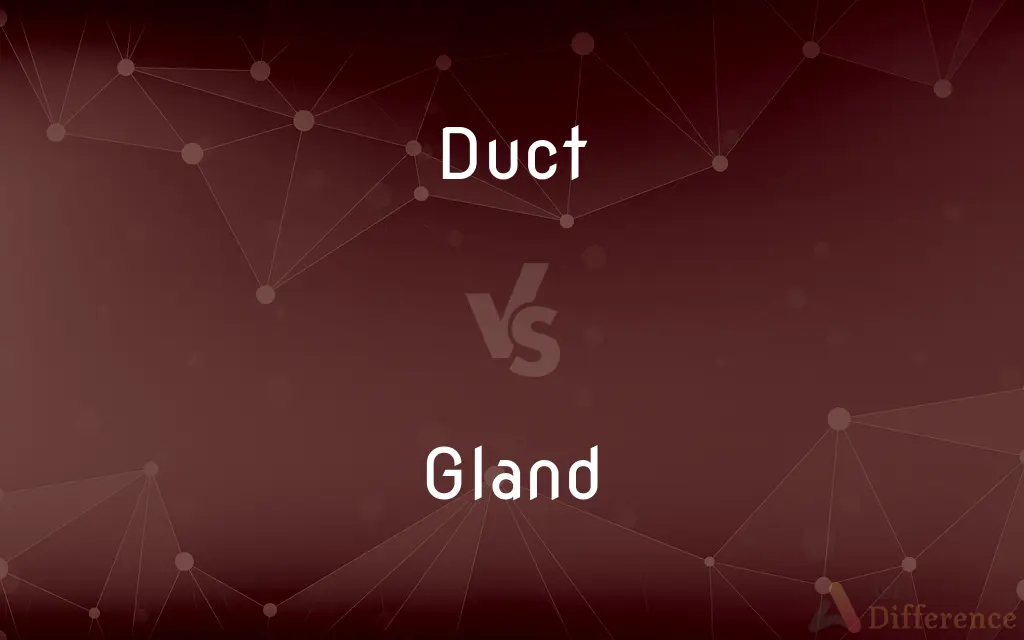Duct vs. Gland — What's the Difference?
By Urooj Arif & Fiza Rafique — Updated on April 16, 2024
A duct is a channel through which fluids or gases are conveyed, while a gland is an organ that produces and releases substances such as hormones or enzymes.

Difference Between Duct and Gland
Table of Contents
ADVERTISEMENT
Key Differences
Ducts are passages used primarily to transport liquids or gases from one area of the body to another, playing crucial roles in systems like the digestive and respiratory tracks. On the other hand, glands are specialized organs that secrete chemicals necessary for the body to function, such as hormones, enzymes, or sweat.
While ducts do not produce any substances but merely act as conduits, glands are involved in the production and secretion of various substances. Glands can be categorized as endocrine, which release their products directly into the bloodstream, or exocrine, which use ducts to deliver their products to a surface or into body cavities.
Many glands, especially exocrine ones, rely on ducts to transport their secretions to their destination. For instance, the pancreas produces digestive enzymes that travel through the pancreatic duct to the small intestine. Conversely, ducts are simply structures without any secretion capabilities.
The structure of ducts tends to be simpler, consisting mainly of tubes that can vary in size and lining type depending on their function, such as moving air, bile, or urine. Glands, however, are more complex, often containing specialized cells that produce, store, and release specific substances in response to the body's needs.
Both ducts and glands are integral to bodily functions but operate differently; ducts as part of the transport infrastructure and glands as part of both the production and delivery system of biochemical agents crucial for health and homeostasis.
ADVERTISEMENT
Comparison Chart
Function
Transports substances
Produces and secretes substances
Types
Bile ducts, bronchial tubes
Endocrine, exocrine
Associated Systems
Digestive, respiratory
All systems (e.g., hormonal, digestive)
Complexity
Simple structure
Complex, cellular structure
Example
Bile ducts carry bile
Sweat glands secrete sweat
Compare with Definitions
Duct
Does not produce substances.
Ducts in the body are merely pathways for moving substances.
Gland
Can be endocrine or exocrine.
Endocrine glands like the pituitary release hormones directly into the bloodstream.
Duct
Found in various body systems.
Air travels through bronchial ducts in the respiratory system.
Gland
Complex structure with specialized cells.
The adrenal glands are composed of cells that synthesize adrenaline.
Duct
Often associated with exocrine glands.
Salivary glands use ducts to deliver saliva to the mouth.
Gland
Integral to bodily functions.
Glands play key roles in systems like the endocrine system for homeostasis.
Duct
Has a simple structural design.
Tear ducts are narrow tubes that drain tears into the nasal cavity.
Gland
Produces substances like hormones, enzymes.
Pancreatic glands produce digestive enzymes.
Duct
A channel that carries fluids or gases.
The bile duct transports bile from the liver to the small intestine.
Gland
An organ that secretes specific substances.
The thyroid gland produces hormones that regulate metabolism.
Duct
An often enclosed passage or channel for conveying a substance, especially a liquid or gas.
Gland
Any of various organs or cell groups, such as the adrenal glands and the salivary glands, that are of endothelial origin and secrete a substance that is used or excreted by the body.
Duct
(Anatomy) A tubular bodily canal or passage, especially one for carrying a glandular secretion
A tear duct.
Gland
Any of various organs, such as lymph nodes, that resemble true glands but perform a nonsecretory function.
Duct
A tube or pipe for enclosing electrical cables or wires.
Gland
(Botany) An organ or a structure that secretes a substance.
Duct
To channel through a duct
Duct the moist air away.
Gland
A device, such as the outer sleeve of a stuffing box, designed to prevent a fluid from leaking past a moving machine part.
Duct
To supply with ducts.
Gland
(anatomy) A structure resembling a gland, especially a lymph node.
Duct
A pipe, tube or canal which carries gas or liquid from one place to another
Heating and air-conditioning ducts
Air duct
Gland
(botany) A secretory structure on the surface of an organ.
Duct
An enclosure or channel for electrical cable runs, telephone cables, or other conductors
Bus duct
Gland
(mechanics) A compressable cylindrical case and its contents around a shaft where it passes through a barrier, intended to prevent the passage of a fluid past the barrier, used for example around a ship’s propeller shaft or around a tap, valve or faucet.
Duct
(anatomy) a vessel for conveying lymph or glandular secretions such as tears or bile
Gland
An organ for secreting something to be used in, or eliminated from, the body; as, the sebaceous glands of the skin; the salivary glands of the mouth.
Duct
(botany) a tube or elongated cavity (such as a xylem vessel) for conveying water, sap, or air
Gland
A special organ of plants, usually minute and globular, which often secretes some kind of resinous, gummy, or aromatic product.
Duct
(physics) a layer (as in the atmosphere or the ocean) which occurs under usually abnormal conditions and in which radio or sound waves are confined to a restricted path
Gland
The movable part of a stuffing box by which the packing is compressed; - sometimes called a follower. See Illust. of Stuffing box, under Stuffing.
Duct
(obsolete) guidance, direction
Gland
The crosspiece of a bayonet clutch.
Duct
To enclose in a duct
Duct
To channel something (such as a gas) or propagate something (such as radio waves) through a duct or series of ducts
Duct
Any tube or canal by which a fluid or other substance is conducted or conveyed.
Duct
One of the vessels of an animal body by which the products of glandular secretion are conveyed to their destination.
Duct
A large, elongated cell, either round or prismatic, usually found associated with woody fiber.
Duct
Guidance; direction.
Duct
A bodily passage or tube lined with epithelial cells and conveying a secretion or other substance;
The tear duct was obstructed
The alimentary canal
Poison is released through a channel in the snake's fangs
Duct
A continuous tube formed by a row of elongated cells lacking intervening end walls
Duct
An enclosed conduit for a fluid
Common Curiosities
How do glands differ from ducts?
Glands produce and secrete substances, while ducts only transport these substances.
What is the main function of a duct?
Ducts primarily serve as pathways for transporting fluids and gases within the body.
Can glands operate without ducts?
Endocrine glands function without ducts by secreting hormones directly into the bloodstream, unlike exocrine glands that need ducts.
What role do glands have in the body?
Glands are crucial for producing hormones, enzymes, and other substances necessary for various bodily functions.
What are examples of substances transported by ducts?
Ducts can transport bile, air, tears, or urine depending on their location and function.
Are all ducts part of the exocrine system?
Most are, as they carry secretions to external surfaces or cavities, but ducts in the respiratory and urinary systems are exceptions.
Can disorders affect ducts and glands differently?
Yes, ducts can be blocked or damaged, impairing transport, while glands can malfunction in secretion, impacting bodily functions.
What is the significance of ductless glands in endocrine function?
Ductless glands, or endocrine glands, are vital for secreting hormones that regulate many aspects of health and development.
What is a common disease involving ducts?
Gallstones can block bile ducts, causing pain and digestive problems.
What substances do glands produce?
Glands produce a variety of substances including hormones, enzymes, sweat, saliva, and more.
How does the structure of glands compare to ducts?
Glands are complex and contain cells specialized for secretion, whereas ducts are simpler structures.
How do ducts support the function of glands?
In exocrine glands, ducts are essential for delivering secretions from the gland to their action sites.
How do environmental factors affect glands and ducts?
Factors like temperature and humidity can influence the activity of sweat glands and their ducts.
Are there technological or medical uses of understanding ducts and glands?
Yes, treatments for diseases like cancer and diabetes often involve targeting specific glands or improving duct function.
What research is being done on glands and ducts?
Ongoing research includes studies on improving treatments for glandular diseases and engineering artificial glands.
Share Your Discovery

Previous Comparison
Adiabatic vs. Polytropic
Next Comparison
Subordinate vs. SupervisorAuthor Spotlight
Written by
Urooj ArifUrooj is a skilled content writer at Ask Difference, known for her exceptional ability to simplify complex topics into engaging and informative content. With a passion for research and a flair for clear, concise writing, she consistently delivers articles that resonate with our diverse audience.
Co-written by
Fiza RafiqueFiza Rafique is a skilled content writer at AskDifference.com, where she meticulously refines and enhances written pieces. Drawing from her vast editorial expertise, Fiza ensures clarity, accuracy, and precision in every article. Passionate about language, she continually seeks to elevate the quality of content for readers worldwide.














































